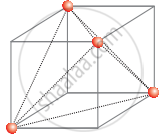Advertisements
Advertisements
प्रश्न
Show that in a cubic close packed structure, eight tetrahedral voids are present per unit cell.
उत्तर
In ccp structure unit cell is divided into 8 small cubes. Each small cube has atoms at alternative corners [Figure]. In all, each small cube has 4 atoms. When joined to one another, they make a regular tetrahedron. Thus, there is one tetrahedral void in each small cube and 8 tetrahedral void in total. Each of the eight small cubes has one void in one unit cell of ccp structure. We know that ccp structure has four atoms per unit cell. Thus the number of tetrahedral voids is twice the number of atoms.
(a)

(b)
Again, the number of tetrahedral voids in ccp structure is equal to twice the total number of atoms.
APPEARS IN
संबंधित प्रश्न
If AgI crystallises in zinc blende structure with I– ions at lattice points. What fraction of tetrahedral voids is occupied by Ag+ ions?
Which set of following characteristics for ZnS crystal is correct?
Percentages of free space in cubic close packed structure and in the body-centered packed structure are respectively:
The number of octahedral voids present in a lattice is A. The number of closed packed articles, the number of tetrahedral voids generated is B the number of closed packed particles:
In the hexagonal close-packed structure of a metallic lattice, the number of nearest neighbours of a metallic atom is ____________.
If Germanium crystallises in the same way as diamond, then which of the following statement is not correct?
In the cubic close packing, the unit cell has ______.
The coordination number of Y will be in the XY types of crystal:
Which of the following is not true about the voids formed in 3 dimensional hexagonal close packed structure?
(i) A tetrahedral void is formed when a sphere of the second layer is present above triangular void in the first layer.
(ii) All the triangular voids are not covered by the spheres of the second layer.
(iii) Tetrahedral voids are formed when the triangular voids in the second layer lie above the triangular voids in the first layer and the triangular shapes of these voids do not overlap.
(iv) Octahedral voids are formed when the triangular voids in the second layer exactly overlap with similar voids in the first layer.
In a compound, nitrogen atoms (N) make cubic close packed lattice and metal atoms (M) occupy one-third of the tetrahedral voids present. Determine the formula of the compound formed by M and N?
